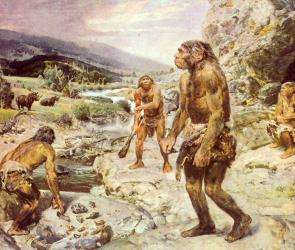February 11, 2010 report
Could Neanderthals live again?

(PhysOrg.com) -- Researchers are closer than ever to having a first draft of a complete sequence of the genome of a Neanderthal woman who lived some 30,000 years ago, and this means it may one day be possible to create a living person from the DNA sequence.
The Neanderthal woman died in the Vindija cave in what is now Croatia. Neanderthals are the nearest extinct relative of modern-day humans. Homo sapiens and Neanderthals coexisted for 5-7,000 years, but Neanderthals were gradually forced to retreat to the edges of what is now Europe. The fragments of DNA from the woman's bones were assembled using human and chimpanzee genomes as references. Researcher Gerald Irzyk said putting the fragments in order is difficult because at first it seems a random assemblage of the nucleotide bases, but there are patterns and motifs that are often specific to a group of organisms.
The project to map the genome began in 2005, and is run collaboratively by scientists at the Max Planck Institute in Leipzig, Germany and 454 Life Sciences at Branford, Connecticut. The work has been made possible by today’s powerful computers, which enable scientists to drastically cut the time and cost, but it has still faced many challenges largely through contamination and the breakdown and chemical changes in the biological material over time.
When an organism dies, enzymes break DNA into small fragments of only a few hundred base pairs or less. The DNA is also chemically changed over time, which can lead to incorrect interpretations of the sequence. Not only that, but over 90% of the DNA in the samples came from bacteria or other contaminants rather than the bone.
Creating body parts, organs, and even a complete living individual once the genome is completely sequenced would be difficult but is theoretically possible. The procedure would involve making possibly millions of changes to the DNA in a human stem cell to match the Neanderthal genetic sequence, but there remain problems because even if the Neanderthal genes could be recreated we do not know how they were expressed. Assuming it can be created, the stem cell with Neanderthal DNA would divide to produce a colony of cells that could then be instructed to become any type of cell in the body, theoretically including an entire individual.
Chief science officer of Advanced Cell Technology, Robert Lanza said in Archaeology magazine that “species such as cows and goats are now routinely cloned with few problems,” and while there are many more challenges in the case of cloning a Neanderthal, it possibly could be done. The ethics of such a move would be certain to spark a great deal of debate, and not just between paleoanthropologists.
Author of the Archaeology magazine article, Zach Zorich, who has been a keen follower of research on the Neanderthal genome, noted that if created, the Neanderthal would legally deserve the same human rights as we do.
It is likely to be quite some time before we need to deal with the ethical issues. Stephan Schuster, a geneticist from Pennsylvania State University, explained that the first draft of the genome will probably contain many errors due to the age of the sample and the contamination, and he calculates the DNA in five different samples of bone would have to be sequenced, and in all the genome would need to be sequenced 30 times before we could be confident of its accuracy.
Mapping the genome should allow scientists to answer questions about the relationship between us and Neanderthals, such as whether we interbred, and were separate species. It may also be useful in medical research.
More information: www.archaeology.org/1003/etc/neanderthals.html
© 2010 PhysOrg.com

















